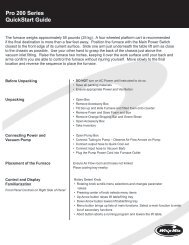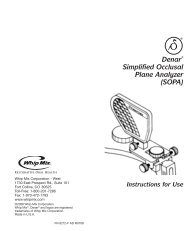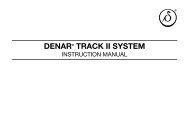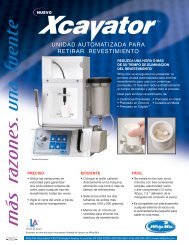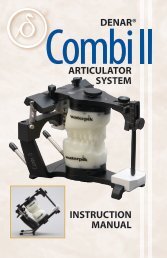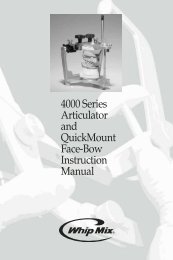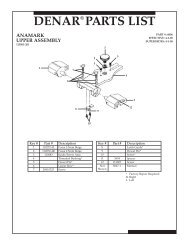Mark II Instruction Manual - Whip Mix
Mark II Instruction Manual - Whip Mix
Mark II Instruction Manual - Whip Mix
Create successful ePaper yourself
Turn your PDF publications into a flip-book with our unique Google optimized e-Paper software.
fig. 26 fig. 27<br />
The closer the functioning tooth incline<br />
is to the condylar path of movement the<br />
more the tooth incline simulates that<br />
condylar path of movement. The interrelating<br />
tooth inclines on the orbiting<br />
side in figure 26A have steep inclines to<br />
complement the path of movement of<br />
the orbiting condyle.<br />
Figure 26B illustrates a left lateral movement.<br />
Due to the fact that the left rotating<br />
condyle is moving straight outward<br />
the left maxillary buccal cusps must be<br />
kept short to allow the left mandibular<br />
buccal cusps to escape. It is this influence<br />
of the rotating and orbiting condylar<br />
paths on occlusal anatomy that<br />
establishes the Curve of Wilson. The<br />
more posteriorly we progress in the<br />
dental arches the mandibular teeth take<br />
on a greater lingual inclination and the<br />
maxillary teeth take on a greater buccal<br />
inclination to harmonize occlusal<br />
anatomy to condylar paths of movement<br />
(fig. 27). The condyle tracks a path<br />
in its fossa just as a buccal cusp of a<br />
lower molar tracks a path in its fossa on<br />
the occlusal surface of an upper molar.<br />
For all practical purposes in the use of<br />
articulators to establish dental articulation,<br />
the temporo-mandibular joint can<br />
just be thought of as another tooth, the<br />
fourth molar – another anatomic control<br />
of jaw movement (figs. 26C and 27).<br />
15





